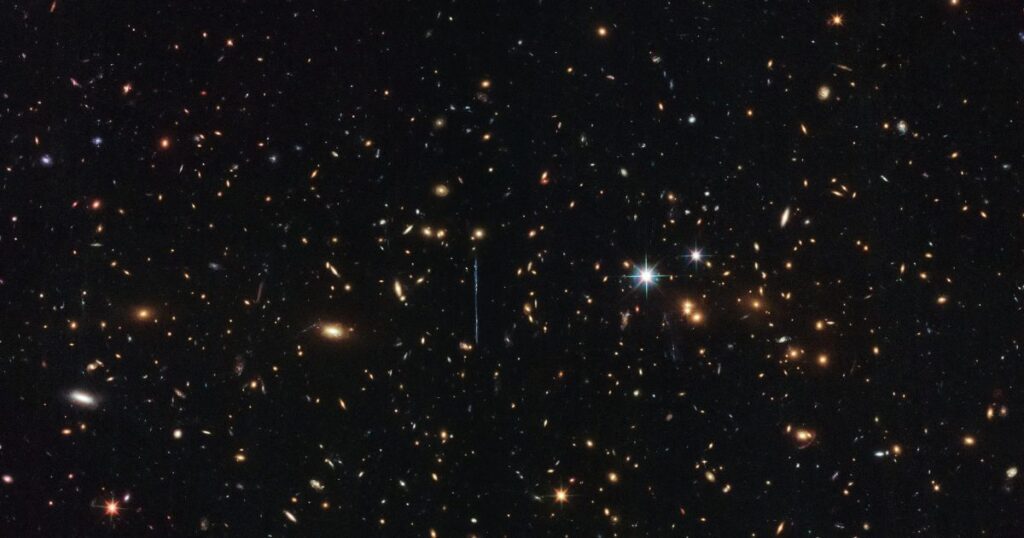Sign up for the Starts With a Bang newsletter
Travel the universe with Dr. Ethan Siegel as he answers the biggest questions of all.
For nearly 100 years, we’ve known our Universe is expanding.

Possible fates of the expanding Universe. Notice the differences between models in the past; only a Universe with dark energy matches our observations, and the dark energy-dominated solution came from de Sitter all the way back in 1917. By observing the expansion rate today and measuring the components present in the Universe, we can determine both its future and past histories.
Einstein’s equations forbid static, stable, uniform solutions.
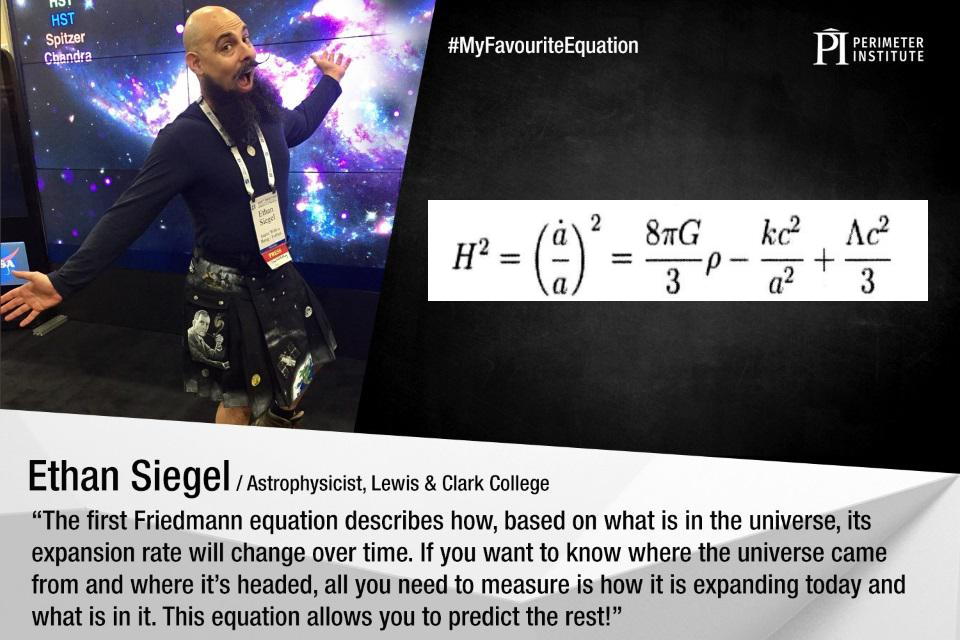
A photo of Ethan Siegel at the American Astronomical Society’s hyperwall in 2017, along with the first Friedmann equation at right. The first Friedmann equation, an exact solution in general relativity, details the Hubble expansion rate squared on the left hand side, which governs the evolution of spacetime. The right side includes all the different forms of matter and energy, along with spatial curvature (in the final term), which determines how the Universe evolves in the future. This has been called the most important equation in all of cosmology and was derived by Friedmann in essentially its modern form back in 1922.
Observations of galactic distances and redshifts validate an expanding Universe.

This graph shows the 1550 supernovae that are a part of the Pantheon+ analysis, plotted as a function of magnitude versus redshift. The supernova data, for many decades now (ever since 1998), has pointed toward a Universe that expands in a particular fashion that requires something beyond matter, radiation, and/or spatial curvature: a new form of energy that drives the expansion, known as dark energy. The supernovae all fall along the line that our standard cosmological model predicts, with even the highest-redshift, most far-flung type Ia supernovae adhering to this simple relation. Calibrating the relation without substantial error is of paramount importance.
The evidence supporting our cosmic expansion has been overwhelming since the 1920s.

Edwin Hubble’s original plot of galaxy distances, from 1929, versus redshift (left), establishing the expanding Universe, versus a more modern counterpart from approximately 70 years later (right). Many different classes of objects and measurements are used to determine the relationship between distance to an object and its apparent speed of recession that we infer from its light’s relative redshift with respect to us. As you can see, from the very nearby Universe (lower left) to distant locations over a billion light-years away (upper right), this very consistent redshift-distance relation continues to hold. Earlier versions of Hubble’s graph were composed by Georges Lemaître (1927) and Howard Robertson (1928), using Hubble’s preliminary data.
But not everything in our Universe expands.

From macroscopic scales down to subatomic ones, the sizes of the fundamental particles play only a small role in determining the sizes of composite structures. Whether the building blocks are truly fundamental and/or point-like particles is still not known, but we do understand the Universe from large, cosmic scales down to tiny, subatomic ones. The scale of electrons, quarks, and gluons is the limit to how far we’ve ever probed nature: down to scales of ~10^-19 meters, where these structures remain point-like.
Atoms, molecules, and human beings aren’t expanding; our sizes remain static.

This drawing illustrates the interactions of water molecules with one another. Water is a V-shaped, highly polar molecule, possessing a negatively charged side (where the oxygen atom is) and positively charged ends where the hydrogens are. Neighboring water molecules interact with one another by way of hydrogen bonds, depicted with dotted lines in this drawing. The size of a water molecule, as well as the size of a body of water containing many such molecules, does not change as the Universe expands.
Credit: すじにくシチュー/Wikimedia Commons, modified by E. Siegel
Similarly, the Earth’s, Sun’s, and Solar System’s distances don’t expand.
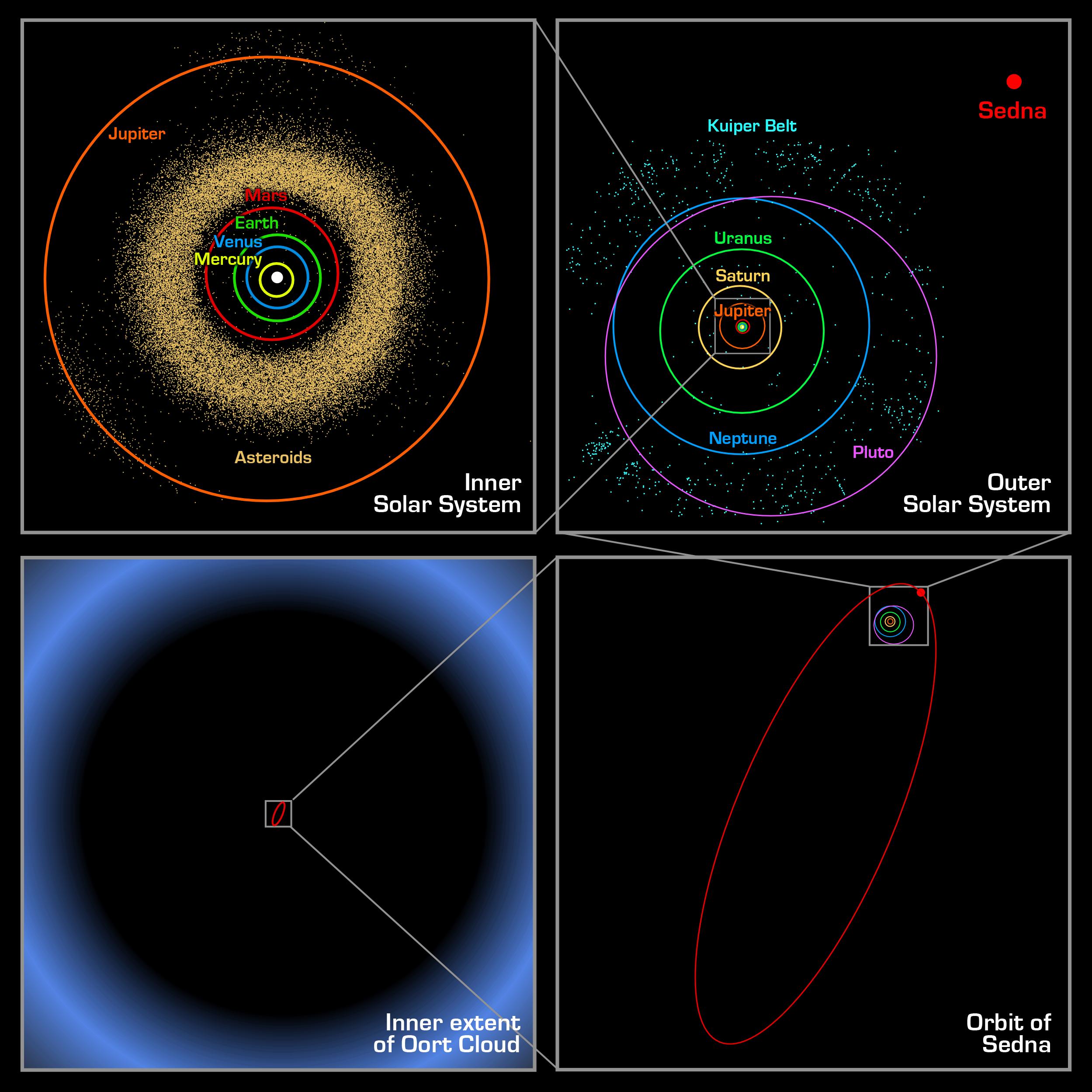
The inner Solar System, including the planets, asteroids, gas giants, Kuiper belt, and more, is minuscule in scale when compared to the extent of the Oort Cloud. Sedna, the only large object with a very distant aphelion, may be part of the innermost portion of the inner Oort Cloud, but even that is disputed. On a linear scale, depicting the entire Solar System in a single image is incredibly limiting; to characterize the orbit of a faraway bound object requires years or even centuries of data. Everything within our Solar System, excepting the rare hyperbolic or interstellar comet, is gravitationally bound together and no longer part of the expanding Universe.
Credit: NASA/JPL-Caltech/R. Hurt
Even in the Milky Way’s outskirts, stellar orbits remain stable; they don’t expand.
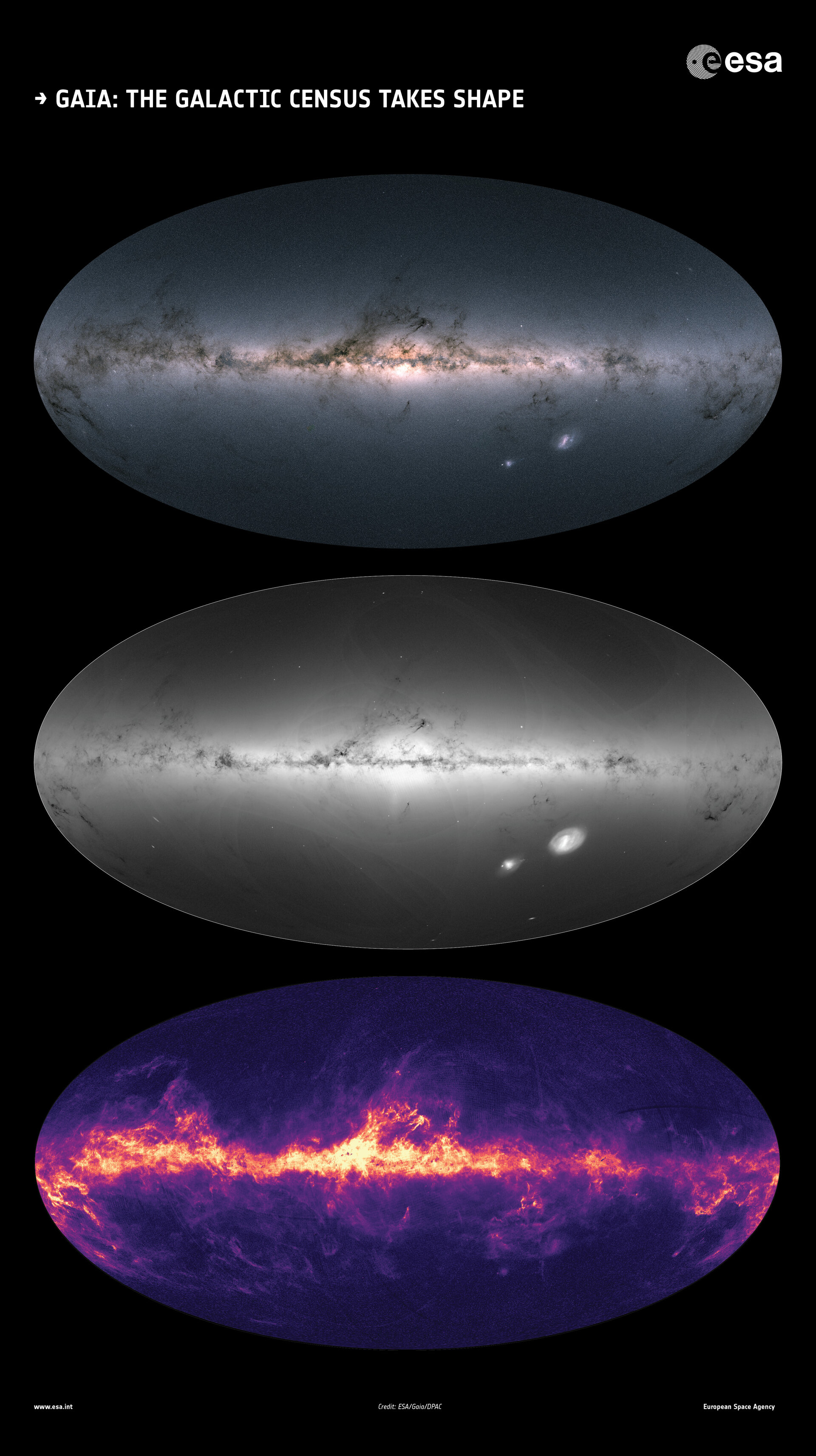
Gaia’s all-sky view of our Milky Way Galaxy and its nearest neighboring galaxies. The maps show the total brightness and color of stars (top), the total density of stars (middle), and the interstellar dust that fills the galaxy (bottom). Note how, on average, there are approximately ~10 million stars in each square degree, but that some regions, like the galactic plane or the galactic center, have stellar densities well above the overall average. All of the material shown here is gravitationally bound together, both within the Milky Way itself and beyond it as part of the greater Local Group.
Credit: ESA/Gaia/DPAC
Other Local Group galaxies don’t recede; they’re gravitationally bound.

Our Local Group of galaxies is dominated by Andromeda and the Milky Way, but there’s no denying that Andromeda is the biggest, the Milky Way is #2, Triangulum is #3, and the LMC is #4. There are over 100 galaxies within the Local Group, but Andromeda and the Milky Way contain most of the stars, as well as most of the mass. All of the galaxies within the Local Group are gravitationally bound together, and the distances between them do not increase as the Universe expands.
Credit: Andrew Z. Colvin/Wikimedia Commons
What determines the dividing line between expanding versus non-expanding?

This illustrated map of our local supercluster, the Virgo supercluster, spans more than 100 million light-years and contains our Local Group, which has the Milky Way, Andromeda, Triangulum, and a couple of hundred smaller galaxies. The overdense regions gravitationally attract us, while the regions of below-average density effectively repel us relative to the average cosmic attraction. However, the individual groups-and-clusters, though gravitationally bound themselves, are not gravitationally bound together to one another and instead recede away from one another as dark energy continues to dominate the cosmic expansion.
It’s whether any local region of space became “bound” before dark energy began dominating the overall expansion.
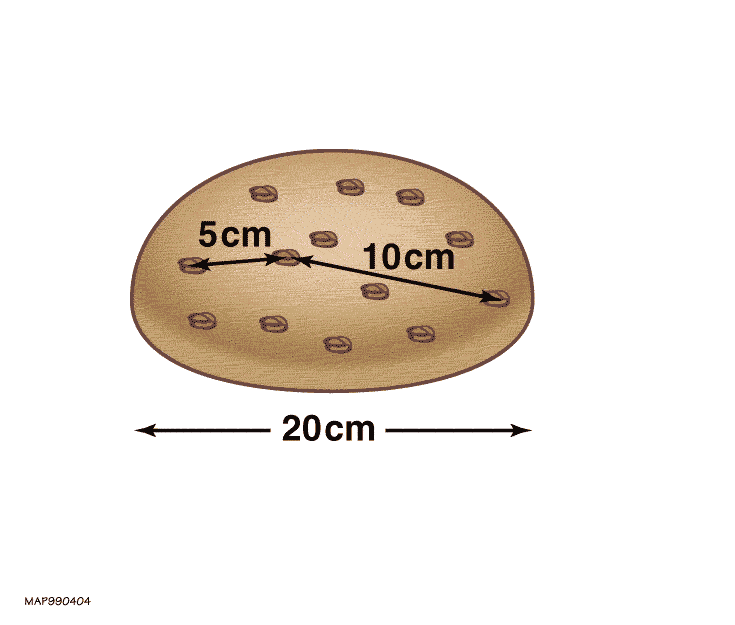
The ‘raisin bread’ model of the expanding Universe, where relative distances increase as the space (dough) expands, but the individual bound objects themselves (represented by raisins) do not expand. The farther away any two raisins are from one another, the greater the observed redshift will be by the time the light is received. The redshift-distance relation predicted by the expanding Universe is borne out in observations and has been consistent with what’s been known since the 1920s.
If something becomes bound through:

In theory, any type of baryon, or entity made of three quarks, can bind together to any other type of baryon. However, while protons-and-neutrons can bind together to form stable bound states (like atomic nuclei), neutrons-and-neutrons and protons-and-protons do not. The deuteron, or a bound state of a proton-and-neutron (shown here), is an example of a composite structure held together primarily through nuclear forces.
Credit: R. Shneor/Tel Aviv University
- the electromagnetic force,

Molecules, examples of particles of matter linked up into complex configurations, attain the shapes and structures that they do owing primarily to the electromagnetic forces that exist between their constituent atoms and electrons. The variety of structures that can be created is almost limitless, but the atoms themselves, as well as the distance between them within a molecule that contains those atoms, do not expand as the Universe does.
Credit: denisismagilov
- or even the gravitational force,

Shown here are two views of the nearby, Milky Way-like galaxy Messier 63: the Sunflower galaxy. While the stellar extent of the galaxy is normally only shown to overlap with the bright dusty disk, superior techniques can reveal the low surface-brightness halo and streams around it. Those extended features show the true stellar extent of the galaxy, and are required to make an accurate determination of its total stellar mass. The entirety of the matter within the galaxy, including the stellar streams along the outskirts, are gravitationally bound to it, ensuring it doesn’t expand along with the greater Universe.
Credit: R. Jay Gabany (Blackbird Obs.); D. Martínez-Delgado (MPIA and IAC) et al.
then locally, the spacetime surrounding it won’t expand.

This side-by-side image shows galaxy cluster Abell S1063 as imaged with JWST (left) and Hubble (rotated, right). The longer wavelength coverage and greater exposure time with JWST reveals features that Hubble never could have hoped to see. As massive as this galaxy cluster is, it only causes the space within a few tens of millions of light-years around it to not expand away as part of the expanding Universe. Beyond that extent, objects are no longer gravitationally bound to it.
Credit: ESA/Webb, NASA & CSA, H. Atek, M. Zamani (ESA/Webb); Acknowledgement: R. Endsley (L); NASA, ESA, and J. Lotz (STScI) (R)
The Universe evolved for 7.8 billion years before dark energy’s effects became dominant.

Dark matter has been largely important for extremely long cosmic times, and we can see its signatures in even the Universe’s earliest signals. Meanwhile, radiation was dominant for the first ~10,000 years of the Universe after the Big Bang. Dark energy came to dominate the Universe’s expansion rate approximately 6 billion years ago: when 7.8 billion years had elapsed since the Big Bang. Note that in the future, when dark energy reaches a number near 100%, the energy density of the Universe (and, therefore, the expansion rate) will remain constant arbitrarily far ahead in time.
Credit: E. Siegel
Over that time, galaxies, galaxy groups, and galaxy clusters all formed bound structures.

This snippet from a structure-formation simulation, with the expansion of the Universe scaled out, represents billions of years of gravitational growth in a dark matter-rich Universe. Over time, overdense clumps of matter grow richer and more massive, growing into galaxies, groups, and clusters of galaxies, while the less dense regions than average preferentially give up their matter to the denser surrounding areas. The “void” regions between the bound structures continue to expand, but the structures themselves, once they become bound in any fashion, do not.
Filaments and superclusters created structures up to 1.4 billion light-years across.
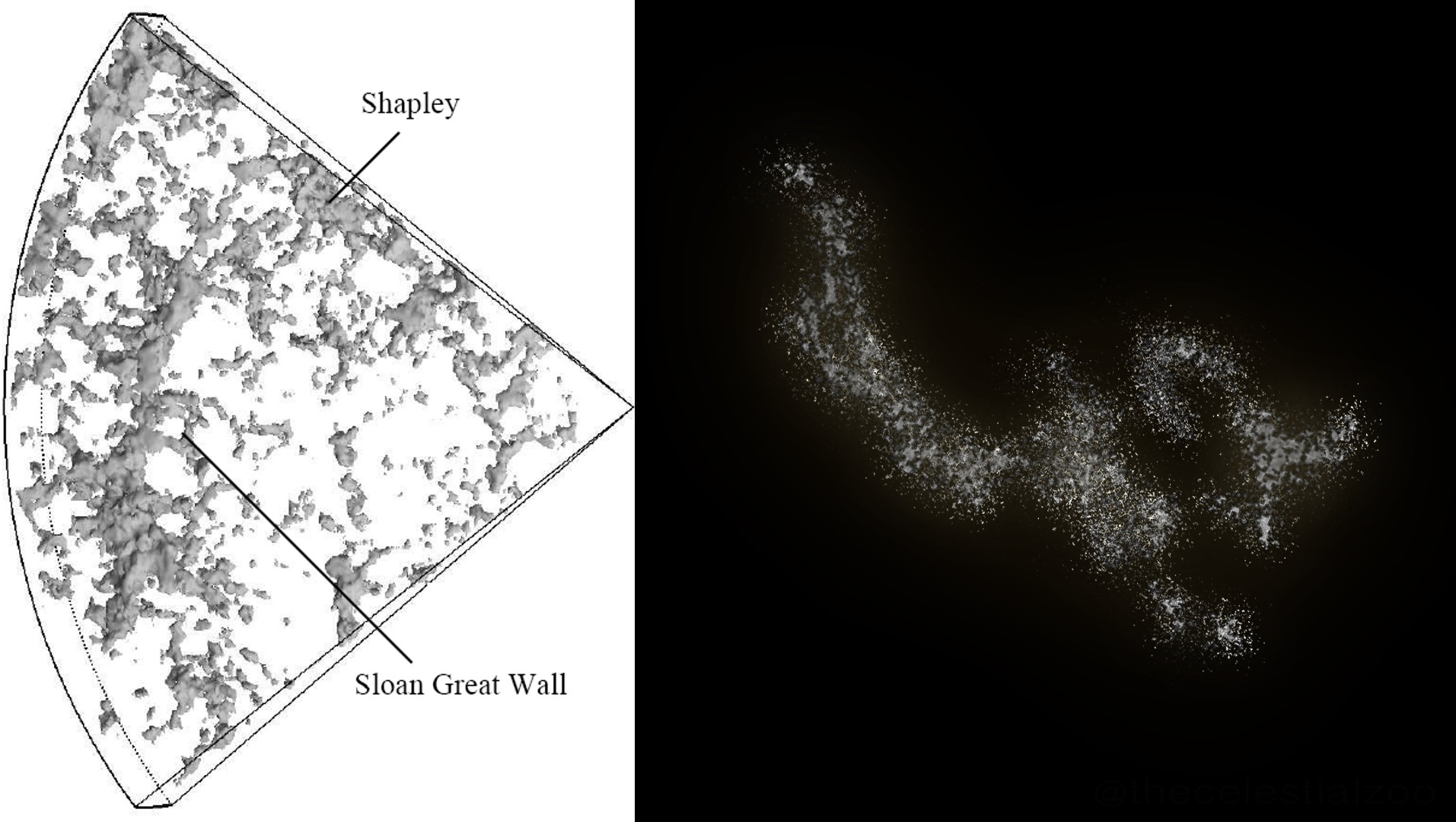
The Sloan Great Wall is one of the largest apparent, though likely transient, structures in the Universe, at some 1.37 billion light-years across. It may just be a chance alignment of multiple superclusters, but observations definitively indicate that it isn’t a single, gravitationally bound structure, as dark energy is in the process of driving it apart. The galaxies of the Sloan Great Wall are depicted at right.
Beyond that, all apparent structures are merely phantasmal.
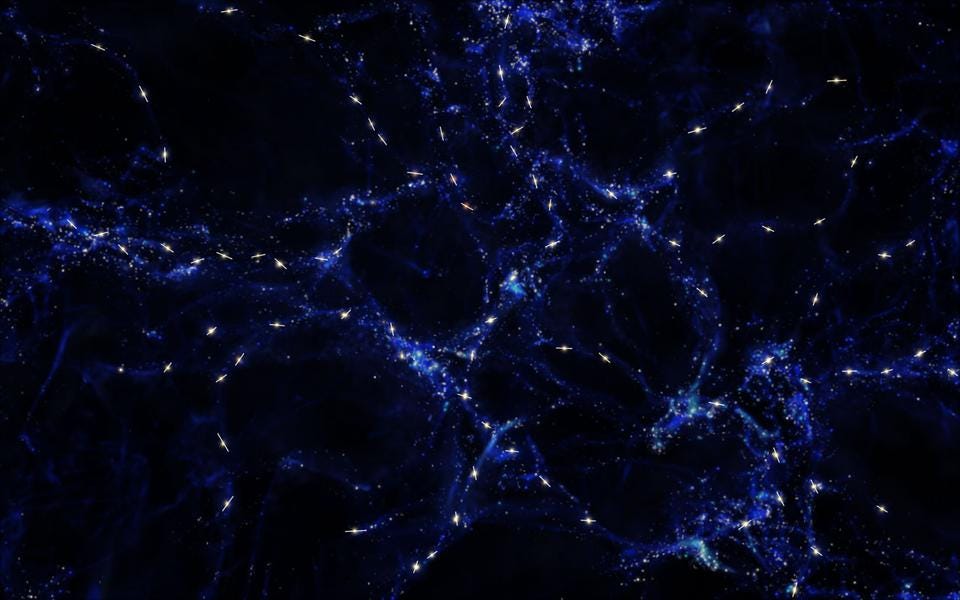
Some quasar groupings appear to be clustered and/or aligned on larger cosmic scales than are predicted. The largest of them, known as the Huge Large Quasar Group (Huge-LQG), consists of 73 quasars spanning up to 5-6 billion light-years, but may only be what’s known as a pseudo-structure. This is true for the giant arc, the big ring, and gamma-ray burst groups as well. Just because it looks like a structure doesn’t mean it’s fairly sampling the underlying matter distribution.
Dark energy actively drives them apart.

The Laniakea supercluster, containing the Milky Way (red dot), is home to our Local Group and so much more: approximately 100,000 to 150,000 known galaxies, at present. Our specific location lies on the outskirts of the Virgo Cluster (large white collection near the Milky Way). Despite the deceptive looks of the image, this isn’t a real structure, as dark energy will drive most of these clumps apart, fragmenting them as time goes on into their component groups, clusters, and isolated galaxies. Today, Laniakea spans 520 million light-years across, but will expand to many billions of light-years as cosmic evolution continues.
Only bound “islands,” adrift within an expanding cosmos, now remain.

This low-resolution image shows the full field of the COSMOS-Web survey conducted with JWST. Spanning 0.54 square degrees in the sky, or nearly three full Moons’ worth of area, this represents the largest, deepest wide-field view of the Universe ever acquired. Within this field, nearly all of the galaxies imaged are bound together in groups and clusters, but the individual groups and clusters themselves are speeding away from one another within the expanding Universe.
Credit: ESA/Webb, NASA & CSA, G. Gozaliasl, A. Koekemoer, M. Franco, and the COSMOS-Web team
Mostly Mute Monday tells an astronomical story in images, visuals, and no more than 200 words.
Sign up for the Starts With a Bang newsletter
Travel the universe with Dr. Ethan Siegel as he answers the biggest questions of all.

